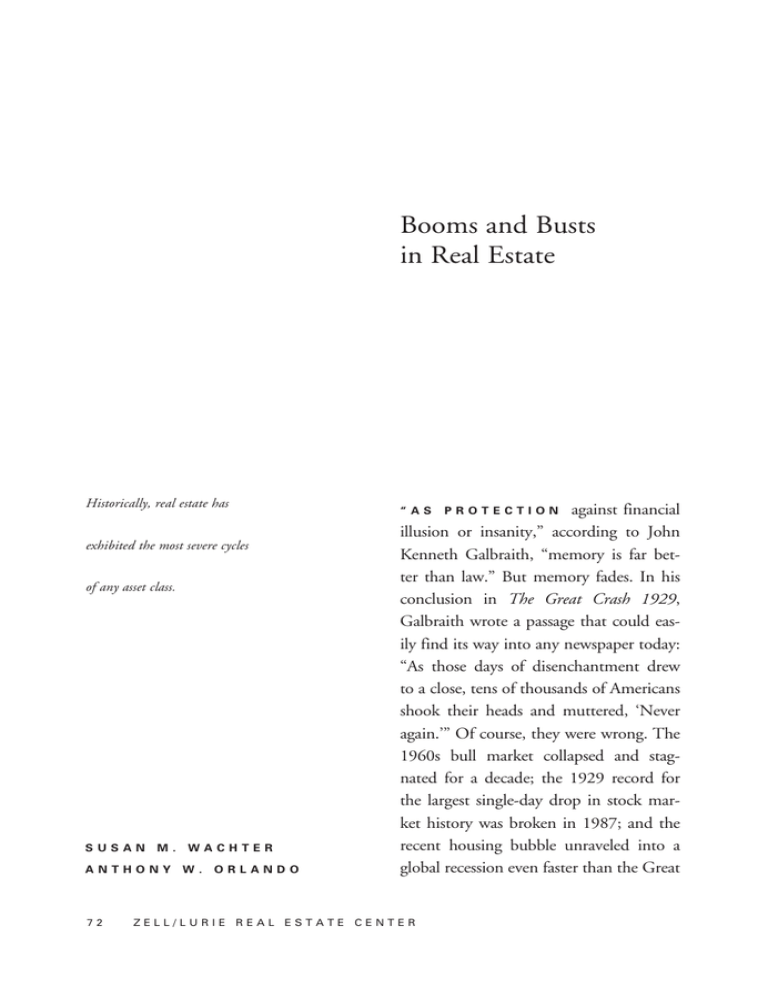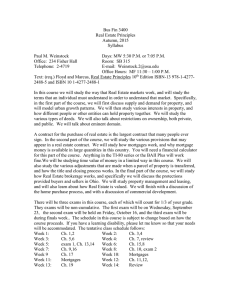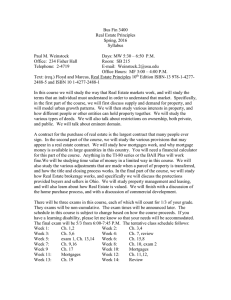Booms and Busts in Real Estate
advertisement

Booms and Busts in Real Estate Historically, real estate has exhibited the most severe cycles of any asset class. SUSAN M. ANTHONY 72 WACHTER W. ORLANDO P R O T E C T I O N against financial illusion or insanity,” according to John Kenneth Galbraith, “memory is far better than law.” But memory fades. In his conclusion in The Great Crash 1929, Galbraith wrote a passage that could easily find its way into any newspaper today: “As those days of disenchantment drew to a close, tens of thousands of Americans shook their heads and muttered, ‘Never again.’” Of course, they were wrong. The 1960s bull market collapsed and stagnated for a decade; the 1929 record for the largest single-day drop in stock market history was broken in 1987; and the recent housing bubble unraveled into a global recession even faster than the Great “AS ZELL/LURIE REAL ESTATE CENTER Depression. The person who declares the boom-and-bust cycle dead is usually the last one to see the next crash coming. The New York Times has already made such a prediction. In August 2010, a headline declared, “Real Estate’s Gold Rush Seems Gone for Good.” The author, David Streitfeld, concluded that “homeownership will never again yield rewards like those enjoyed in the second half of the twentieth century,” a conclusion that rests on the strange assumption that home prices soared after World War II, when in fact they just barely kept pace with inflation. It is unclear whether Streitfeld attributed this “never again” to memory or to law, but the history of real estate casts doubt on both explanations. Historically, real estate has exhibited the most severe cycles of any asset class, with accelerating severity in recent decades. Economists refer to the period from 1980 to 2006 as the “Great Moderation” for its declining interest rates, low inflation, and tame business cycle, but real estate observers are more likely to remember it for the savings and loan crisis, the commercial real estate crash, the East Asian financial crisis, and the housing bubble that led to a global financial crisis. Indeed, any explanation of the recessions of 1980-82 and 1990-91 must involve overbuilding of real estate and the resulting insolvency of financial institutions invested therein. The economy is very dependent on the real estate market, but it is a rather unstable dependence. Economists of every stripe recognize that real estate plays an important role in recurring business cycles. What has been less widely recognized until recently is the separate, though related, credit cycle. As the late financial economist Hyman Minsky warned, financial systems tend to oversupply debt, leading to recurring credit bubbles. In these cases, assets may be efficiently priced and still experience an unsustainable rise because credit is too cheap. More specifically, real estate prices tend to fluctuate beyond their economic fundamentals, first because there is a lag in construction. This was evident in the 1970s and 1980s cycle. Demand increased and was initially unmatched by supply, as building real estate takes time. Prices rose, which made construction even more lucrative. Expecting the prices (and shortterm scarcity) to continue to rise and with current prices exceeding construction costs, builders increased supply more than was needed to meet current demands. Eventually, but with delays, the market realized that too much supply had been built, and prices tumbled back to earth. With full information and no limits to arbitrage, this “coordination failure” should not occur. If construction companies are building too much supply, investors should short-sell the overpriced assets, putting downward pressure on prices. The REVIEW 73 resulting declines in prices should halt overbuilding. Unfortunately, in many real estate sectors, it is difficult to impossible to short-sell the underlying asset. Thus, there is limited short pressure to correct incipient price bubbles and the ensuing bust. THE ROARING TWENTIES The first twentieth-century American real estate boom and bust occurred, unsurprisingly, during the Roaring Twenties. Irving Fisher, the most famous economist of the 1920s, may be best remembered for declaring that the stock market had reached a “permanent plateau” in 1929, but he probably suffered more personal anxiety for purchasing an expensive house in New Haven just before housing prices tumbled, thrusting him deep into negative equity. Though less infamous than the stock market crash, the housing crisis during the Great Depression was also severe. Peak to trough prices fell more than 25 percent. From 1929 to 1933, the value of residential building permits fell by 90 percent. In 1971, MIT economic historian Peter Temin famously argued that the rise and fall of aggregate investment triggered the Great Depression. More recently, Rutgers economist Eugene N. White has suggested that real estate was the first stage in a “double bubble” that inevitably popped, bringing aggregate investment along with it. 74 Most historians illustrate the magnitude of the Great Depression by describing “Hoovervilles,” large plots of land where the newly homeless would camp under tents within once-booming metropolises. What often goes overlooked, however, is why homelessness was such a problem during this particular recession and not later ones. Throughout the 1920s, banks relied on short-duration mortgages to minimize interest rate risk. Banking is commonly described as the business of “borrowing short and lending long,” but the meaning of “long” has changed over the years. In the 1920s, banks would borrow from depositors and lend to homeowners for three to five years. If interest rates rose, the mortgage ended relatively soon—fortunately for the banks—and they could set new terms. Unfortunately for the homeowners (and ultimately for the banks as well), those terms included higher interest payments. During the Great Depression, homeowners could not pay higher rates, resulting in many foreclosures. Similarly, the housing bubble of the 2000s witnessed a dramatic rise in adjustable-rate mortgages (ARMs), which triggered the initial decline when rates “reset” in mid-2007. For most of postwar history, however, this problem did not exist in the United States. In the 1930s, Congress responded to the housing crisis by creating the Federal National Mortgage Association (“Fannie Mae”) to purchase exclusively ZELL/LURIE REAL ESTATE CENTER long-term, fixed-rate mortgages (FRMs), giving banks an incentive to issue this more stable product. Congress also chartered “savings & loan” organizations (also known as “thrifts”), specifically to issue FRMs unburdened by riskier forms of lending. These thrifts, and the long-term fixed rate mortgage that was a solution to the prior crisis, would feature prominently in the next crisis. THE THRIFTS The second twentieth-century boomand-bust in American real estate was a more drawn-out process, beginning with a run-up in the late 1970s but not exhausting itself until the recession of the early 1990s. Rising inflation pushed interest rates up, eroding thrifts’ profit margins. With a portfolio of FRMs receiving low payments, the cost of borrowing short started to exceed the revenue of lending long. Interest rates reached their peak in the early 1980s, thanks to Paul Volcker and the Federal Reserve, but Congress refused to accept the mark-to-market losses and allowed a decapitalized industry to make riskier commercial real estate loans. Thus, unfortunately, the industry tried to grow its way out of trouble by making risky bets with nothing to lose. From 1986 to 1995, more than 1,000 thrifts filed for bankruptcy, costing taxpayers hundreds of billions of dollars. The thrifts overshot the future path of demand so severely because they financed construction based on current appraisals. The result was that half of the commercial real estate built in the history of the United States was built in the 1980s. But it wasn’t just the thrifts that flooded the market with liquidity; foreign investors, freed by the deregulation of foreign exchange markets in the 1970s, flooded Wall Street with liquidity. Vacancy rates skyrocketed during the ensuing recession but they had begun to rise even before the recession’s onset. Prices fell to 50 cents on the dollar and the “grave dancer” Sam Zell famously and accurately predicted eventual recovery and return to profitably by “staying alive to ’95.” Meanwhile, real estate market participants tried to correct the original overbuilding problem, which would not have occurred if all participants had full information about current and projected construction. Real estate markets needed better real-time information and analysis, price discovery, through liquid real estate that could be short-sold. This was the purpose for the next generation of real estate investment trusts (REITs), whose financial analysts would allocate capital more efficiently and enhance price discovery. REVIEW 75 CREDIT BUBBLES But another change in global markets foiled this hoped-for solution. If they had looked abroad in the late 1990s, observers would have seen that a severe real estate crisis need not depend only on overbuilding. In the East Asian crisis of 1997-98 and Japan’s “lost decade,” real estate prices soared and crashed, but construction did not follow the same amplified path. These episodes were classic “credit bubbles,” too much money chasing too few goods— similar to the inflation of the 1970s, but confined to a specific asset class. Most Americans considered it unlikely that the United States would witness a similar debacle because the United States had historically had greater supply elasticity than the Asian countries. They did not expect demand to outstrip supply, and so they were unprepared for a housing bubble that did not involve overbuilding. Their assumption was outdated. For most of U.S. history, developable land was plentiful, but by the 1990s, it was beginning to run out, partly due to local land use regulations restricting builders’ options. Many observers expected the market to anticipate credit mispricing, however, because traders had invented indirect methods to short sell real estate, such as buying credit default swaps (CDSs) that act like insurance against a default or short-selling REITs. CDSs, however, 76 traded on an opaque, shrouded, dealercentered market where most participants could not receive the information that a short sale is supposed to signal. The CDS issuers, moreover, did not have enough cash to cover their obligations when the underlying assets did default. The REITs, on the other hand, focused most of their attention on commercial real estate, where the last crisis had manifested itself, leaving the residential mortgage market more vulnerable. They gained from the cheap debt, as did Main Street real estate, until of course credit seized up. There was a lack of vehicles to short these mispriced debt instruments sufficiently to stem the flow of underpriced credit. In some ways, the REITs and CDSs may have magnified the possibility of a credit bubble by attracting foreign capital, increasing the amount of money flowing toward limited investments. If you had asked any thrift owner from the 1980s how investment bankers would expand the number of investments to accommodate this money, you would have been told a simple mantra: More risk! Motivated by fees and short-term bonuses, Wall Street increased the supply faster than demand for credit could keep up—which is why rates for MBS and CMBS fell relative to Treasuries and corporate, as shown in recent work by Levitin and Wachter. After the 2000-01 recession, the risk premium—measured ZELL/LURIE REAL ESTATE CENTER by the yield spread of mortgage-backed securities over U.S. Treasuries—declined while the underlying mortgages increased in complexity and heterogeneity, resulting in more risk without compensation through higher rates. From 1996 to 2006, prices increased as never before, in both the commercial and residential market, and when they came back down to earth, the deleveraging cycle sent seismic waves through the global economy. REITs fell even more sharply in value than housing prices, but they recovered more quickly and did not freeze trading activity like many of their underlying mortgages, due in part to the liquidity and price discovery that trading provides. In this, the proponents of the “New REITs” were correct. crunch in 2008. And it goes without saying that anyone who cited their memories of those periods was silenced by the majority during the next bubble. So short are our memories that we often repeal the very laws that our ancestors passed to protect us, as we have either forgotten their intent or deemed them unnecessary. Whether through “irrational exuberance” or market failure, real estate prices will rise and fall for a long time to come. Instead of declaring the cycle dead, observers will find the best use of their time is preparing to weather the next storm. If regulators hope to have any chance of moderating the cycle, they must tend to the root causes: complexity and heterogeneity in the mortgage market, lack of transparency in the securitization market, and the procyclicality of credit during macroeconomic swings. CONCLUSION Now, we are led to believe, through both memory and law (including the newly legislated banking law), that we have newly tamed the forces that have led to the Great Recession. This prediction is as improbable as it was in 1945 and 1995. The banking regulations of the New Deal did not prevent accelerating inflation from bankrupting thrifts, nor did increasing the lending powers of the Fed in the 1990s (similar to the greater power given to regulators in the Dodd-Frank Act) prevent a national credit REVIEW 77






